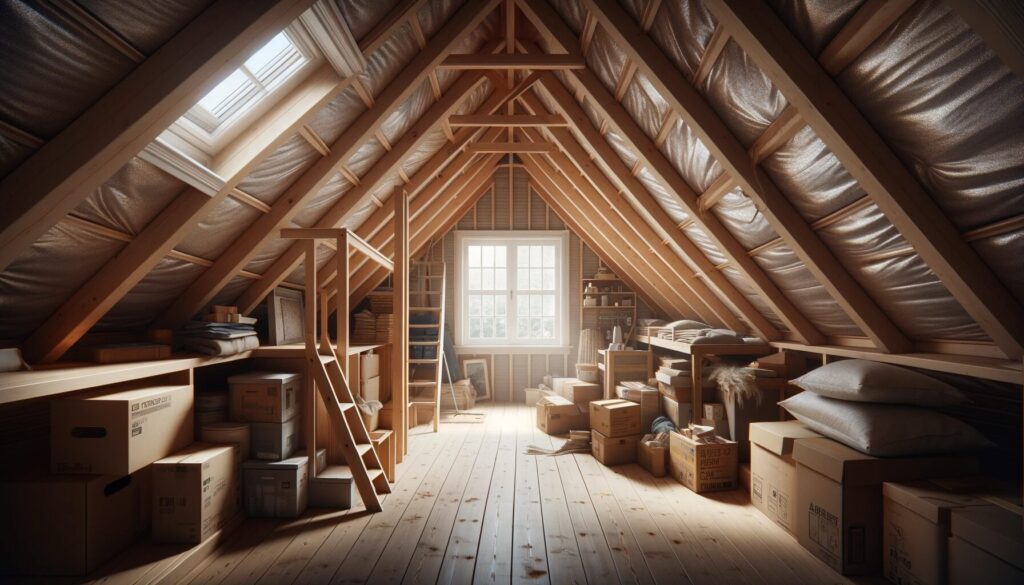When it comes to enhancing your home, installing an attic ladder is a smart move for both savvy DIYers and seasoned construction professionals. It’s a practical, space-efficient solution that adds immense value to your home. Imagine transforming that unused attic space into a functional storage area or a cozy hideaway, all accessible with a simple pull of a ladder. It’s about making the most of every inch of your home.

Choosing the Right Attic Ladder
Picking the perfect attic ladder is a bit like choosing the right tool for a job – it needs to fit your specific needs and space. Let’s break it down:
- Types of Ladders: Pull-down stairs are ideal for regular access – think of it as adding another room to your house. Folding ladders, on the other hand, are great for less frequent use, neatly tucking away when not needed.
- Materials: Wood ladders bring a classic feel and robustness, while aluminum ladders offer lightweight durability and a modern look. Consider the aesthetic of your home and the ladder’s purpose when choosing.
- Key Considerations:
- Weight Capacity: Safety first. Choose a ladder that can comfortably handle the heaviest load you anticipate (plus a little extra for peace of mind).
- Size of the Attic Opening: Measure your opening precisely. If the fit isn’t snug, you might need to do some trimming or framing.
- Ceiling Height: The ladder should match your ceiling height to ensure it can be extended and retracted smoothly.
- Interior Compatibility: The ladder should not only be functional but also blend seamlessly with your home’s design. Safety standards are non-negotiable.
Pre-Installation Preparation
Proper preparation is half the job done. Here’s what you’ll need for a smooth installation:
- Tools and Materials: Arm yourself with a saw (for any adjustments to the opening), a reliable drill, a measuring tape for accuracy, and a level to ensure everything is perfectly aligned. You might also need plywood or boards for framing the opening.
- Safety Gear: Don’t overlook personal safety. Durable gloves and protective eyewear are essential.
Before diving in, inspect the attic space. Ensure the structure can support the new addition – check the joists and be wary of existing wiring or piping. Adjust the opening size if needed, but always keep structural integrity in mind. A clean, clutter-free workspace is not only safer but also makes the installation process smoother.
Installing the Attic Ladder
Now, let’s dive into the heart of the matter: installing that attic ladder. This task, while straightforward, requires attention to detail and precision. I’ll guide you through each step, ensuring that even a beginner can follow along with confidence.
Frame the Attic Opening (If Necessary)
- Before anything else, check if your attic opening needs framing. This is foundational – the structure that supports your ladder. Measure and cut framing members accurately, ensuring each piece fits perfectly.
- Use a level to guarantee everything is straight and true. Misalignment here means trouble later. Securely fasten the frame, using nails or screws, to the surrounding structure.
Position and Secure the Ladder Assembly in the Opening
- Lifting the ladder assembly into place can be cumbersome, so it’s wise to have a helping hand. Position it carefully onto the frame.
- If the fit isn’t exact, don’t force it. Instead, make necessary adjustments to the frame or opening. It’s all about a flush and secure fit.
Attaching and Adjusting the Ladder Length
- With the ladder in place, it’s time to secure it. Use sturdy lag screws for this – they need to handle the ladder’s weight and frequent movement.
- Adjust the ladder so it touches the floor gently. This often involves trimming the legs. Ensure they are of equal length for stability.
Ensuring the Ladder Opens and Closes Smoothly
- Test the ladder’s movement. It should extend and retract without any resistance. If it’s sticky or doesn’t fully open, look at adjusting the spring tension or repositioning the ladder.
- A touch of lubricant on the hinges and springs can work wonders for smooth operation.
Tips on Ensuring a Snug and Secure Fit
- Accurate measurements are your best friend. An error, even a small one, can lead to significant issues.
- Shims can be incredibly helpful in achieving a perfect fit. They help in fine-tuning the position of the ladder for a stable installation.
- Post-installation, conduct a thorough check. A firm shake can reveal a lot about the ladder’s stability. Safety should always be your top priority.

Finishing Touches
Now that your attic ladder is installed, it’s time to give it those final touches that blend functionality with aesthetics, and safety with efficiency.
- Adding Trim or Molding: Like framing a picture, adding trim or molding around your attic opening can transform the overall appearance. Measure the perimeter accurately, cut the trim pieces to size, and secure them in place. A bit of caulking can fill any gaps, giving you that professional, seamless finish.
- Installing Handrails: For added safety, especially if children or the elderly are present, installing stair handrails is a wise decision. Handrail kits are readily available and are straightforward to install – typically, it’s just a matter of securing them with screws as per the instructions provided.
- Insulating the Attic Door: This step is crucial for energy efficiency. Attach rigid foam or batt insulation to the back of the attic door. Cut it to fit snugly, which helps in maintaining a consistent temperature in your home, reducing energy costs.
Maintenance and Safety Checks
To ensure the longevity and safety of your attic ladder, routine maintenance is essential.
- Routine Maintenance Tips: Regularly inspect your ladder for any loose components and tighten them as needed. Annually lubricating the hinges and springs will keep the mechanism operating smoothly.
- Safety Checks: Periodically check the hinges, springs, and locking mechanisms for signs of wear or damage. If you notice any issues, don’t hesitate to repair or replace the faulty parts to maintain the ladder’s safety.
FAQ Section
Key indicators include visible damage like splintering wood, bent or broken steps, and unstable hinges. An attic ladder that feels unsteady or shows significant wear should be replaced to ensure safety.
This depends on your skill level and experience with home projects. If you’re comfortable with tools and understand the basics of home construction, you can attempt it yourself. However, if you’re uncertain, especially about the structural aspects, hiring a professional is recommended.
Examine the joists and framing for strength and integrity. When in doubt, consult a structural engineer to ensure that your ceiling can safely support the ladder.
In older homes, be prepared to encounter unique challenges such as non-standard framing or weakened structures. Extra care and possible reinforcement may be necessary.
Choose a ladder with a locking mechanism to control access. Educate children about ladder safety and always supervise their use.
